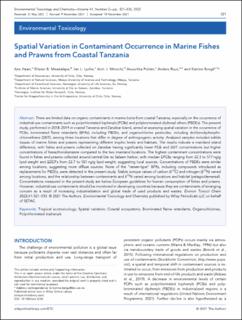Spatial Variation in Contaminant Occurrence in Marine Fishes and Prawns from Coastal Tanzania
Haarr, Ane; Mwakalapa, Eliezer B.; Lyche, Jan Ludvig; Mmochi, Aviti J.; Polder, Anuschka; Ruus, Anders; Borgå, Katrine
Peer reviewed, Journal article
Published version
Permanent lenke
https://hdl.handle.net/11250/2981375Utgivelsesdato
2021Metadata
Vis full innførselSamlinger
Sammendrag
There are limited data on organic contaminants in marine biota from coastal Tanzania, especially on the occurrence of industrial-use contaminants such as polychlorinated biphenyls (PCBs) and polybrominated diphenyl ethers (PBDEs). The present study, performed in 2018–2019 in coastal Tanzania and Zanzibar Island, aimed at assessing spatial variation in the occurrence of PCBs; brominated flame retardants (BFRs), including PBDEs; and organochlorine pesticides, including dichlorodiphenyltrichloroethane (DDT), among three locations that differ in degree of anthropogenic activity. Analyzed samples included edible tissues of marine fishes and prawns representing different trophic levels and habitats. The results indicate a mainland–island difference, with fishes and prawns collected on Zanzibar having significantly lower PCB and DDT concentrations but higher concentrations of hexachlorobenzene compared to the two mainland locations. The highest contaminant concentrations were found in fishes and prawns collected around central Dar es Salaam harbor, with median ΣPCBs ranging from 22.3 to 577 ng/g lipid weight and ΣDDTs from 22.7 to 501 ng/g lipid weight, suggesting local sources. Concentrations of PBDEs were similar among locations, suggesting more diffuse sources. None of the “newer-type” BFRs, including compounds introduced as replacements for PBDEs, were detected in the present study. Stable isotope values of carbon (δ13C) and nitrogen (δ15N) varied among locations, and the relationship between contaminants and δ15N varied among locations and habitat (pelagic/demersal). Concentrations measured in the present study are below European guidelines for human consumption of fishes and prawns. However, industrial-use contaminants should be monitored in developing countries because they are contaminants of emerging concern as a result of increasing industrialization and global trade of used products and wastes.
